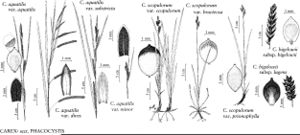Difference between revisions of "Carex scopulorum var. prionophylla"
Syst. Bot. Monogr. 7: 86. 1985.
IllustratedEndemic
Basionym: Carex prionophylla T. Holm Amer. J. Sci. 164: 423. 1902
Synonyms: Carex miserabilis Mackenzie
imported>Volume Importer |
imported>Volume Importer |
||
| Line 63: | Line 63: | ||
|publication year=1985 | |publication year=1985 | ||
|special status=Illustrated;Endemic | |special status=Illustrated;Endemic | ||
| − | |source xml=https:// | + | |source xml=https://bitbucket.org/aafc-mbb/fna-data-curation/src/2e0870ddd59836b60bcf96646a41e87ea5a5943a/coarse_grained_fna_xml/V23/V23_717.xml |
|genus=Carex | |genus=Carex | ||
|section=Carex sect. Phacocystis | |section=Carex sect. Phacocystis | ||
Latest revision as of 20:42, 5 November 2020
Culms 35–90 cm, scabrous on angles. Leaves: proximal sheaths red-brown, fronts with (red) pale brown spots, prominently ladder-fibrillose, bladeless, glabrous, backs scabrous; leaf blades 3–6 mm wide. Perigynia ellipsoid to obovoid, apex acute. 2n = 74.
Phenology: Fruiting Jul–Aug.
Habitat: Wet subalpine meadows
Elevation: 1000–1400 m
Distribution

B.C., Idaho, Mont., Wash.
Discussion
Carex scopulorum var. prionophylla usually occurs at somewhat lower elevations than var. bracteosa. Where the two are sympatric, they can be distinguished by the bladeless, ladder-fibrillose basal sheaths and the narrower ellipsoid perigynia of var. prionophylla.
Selected References
None.
Lower Taxa
None.
